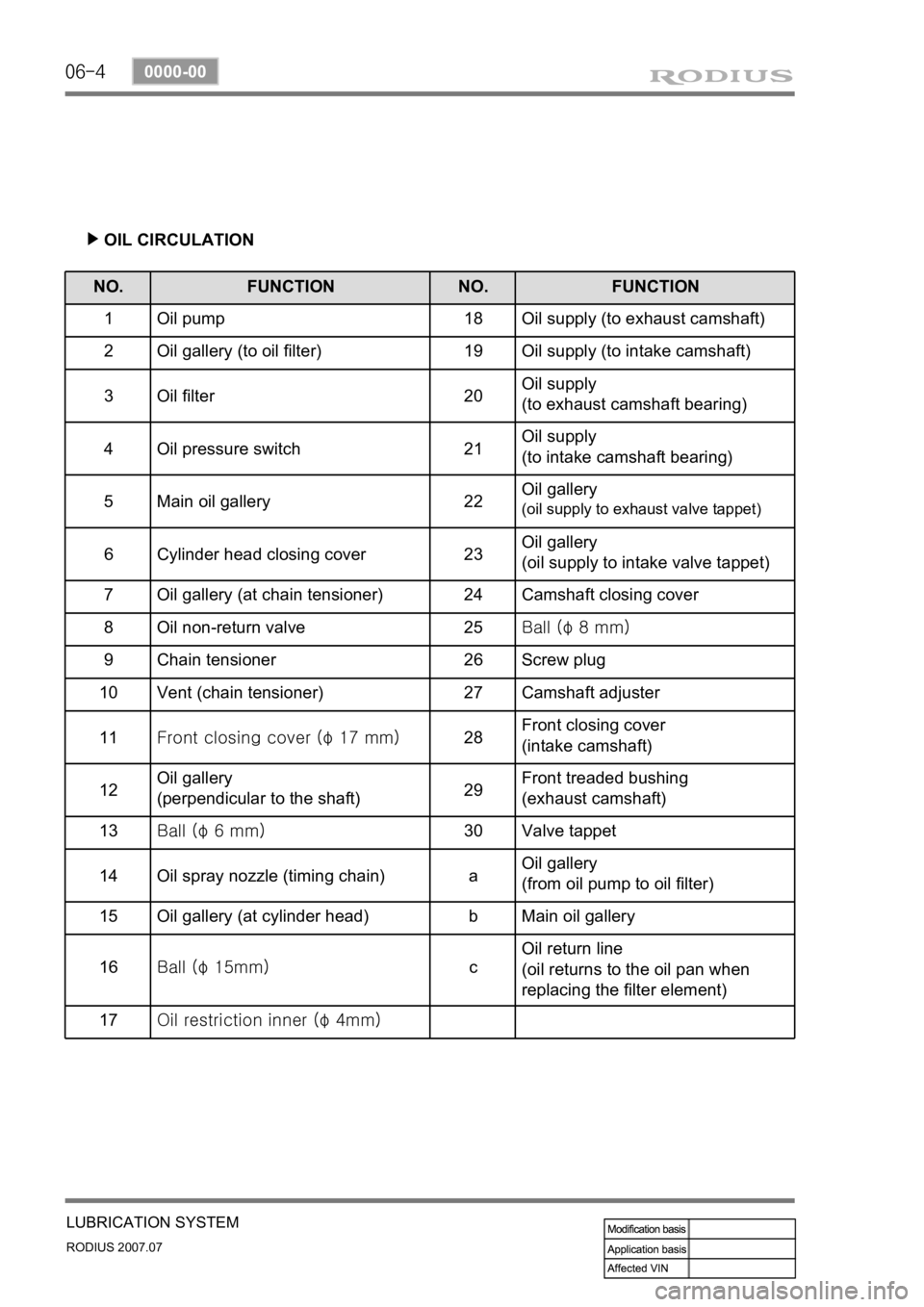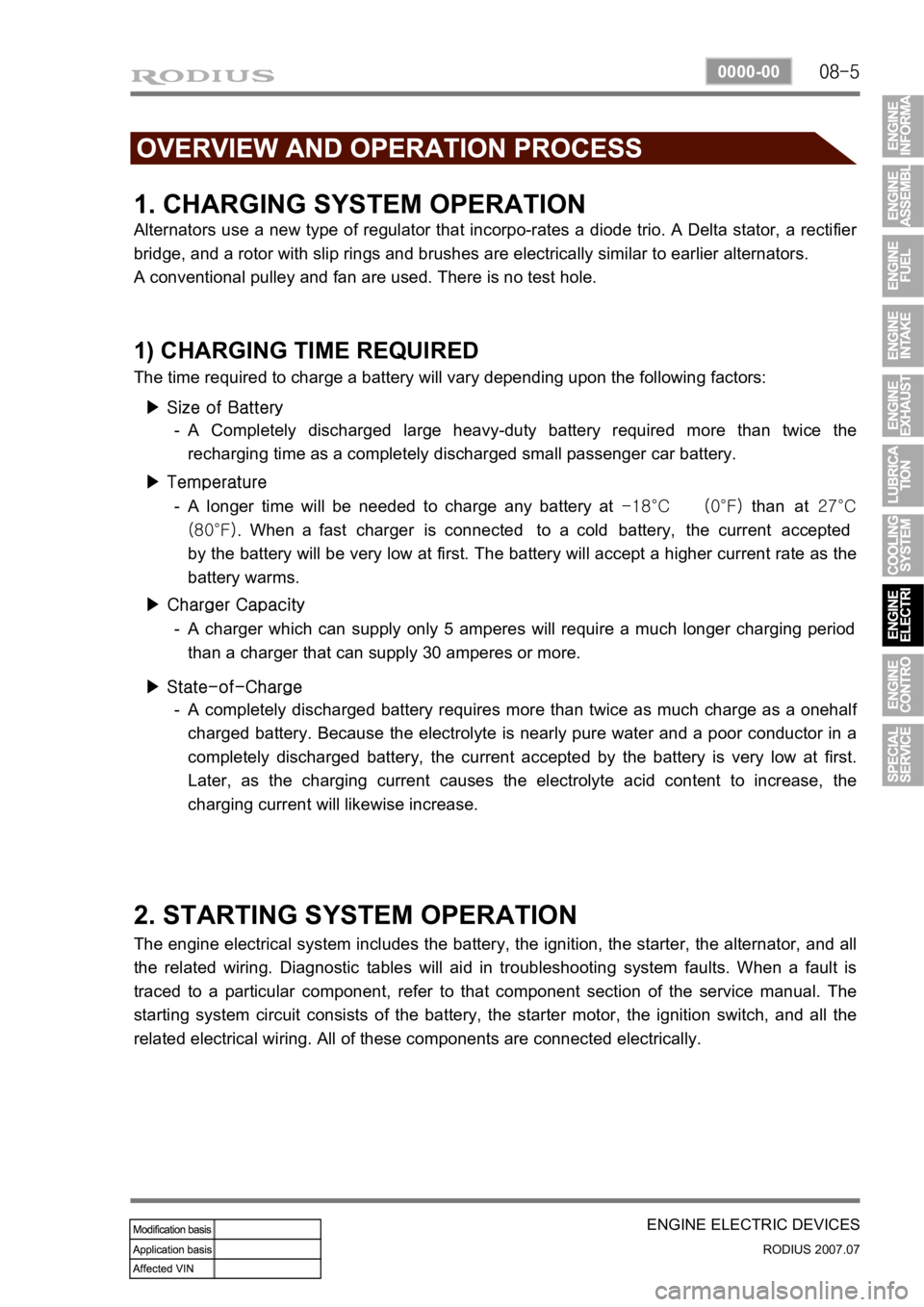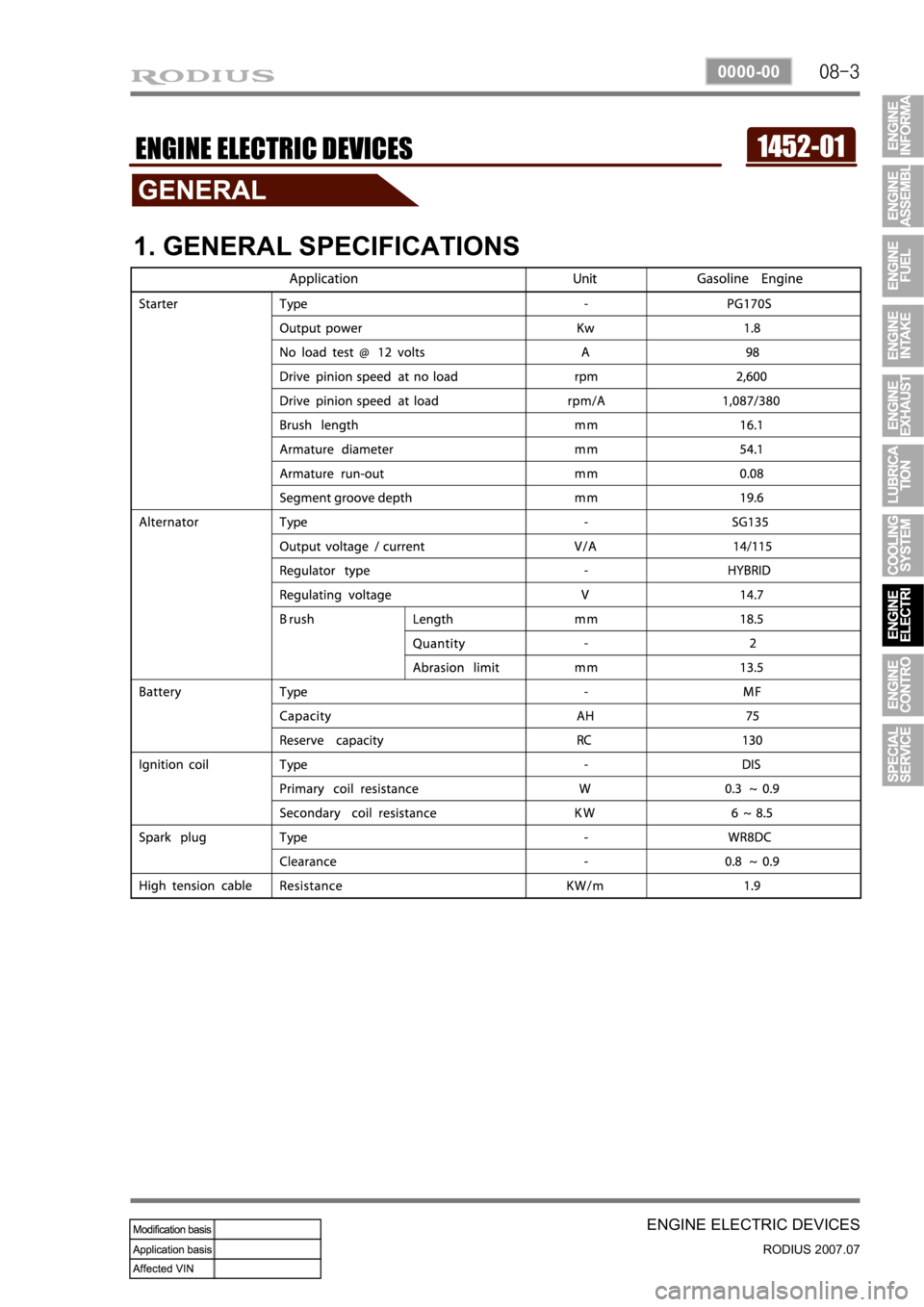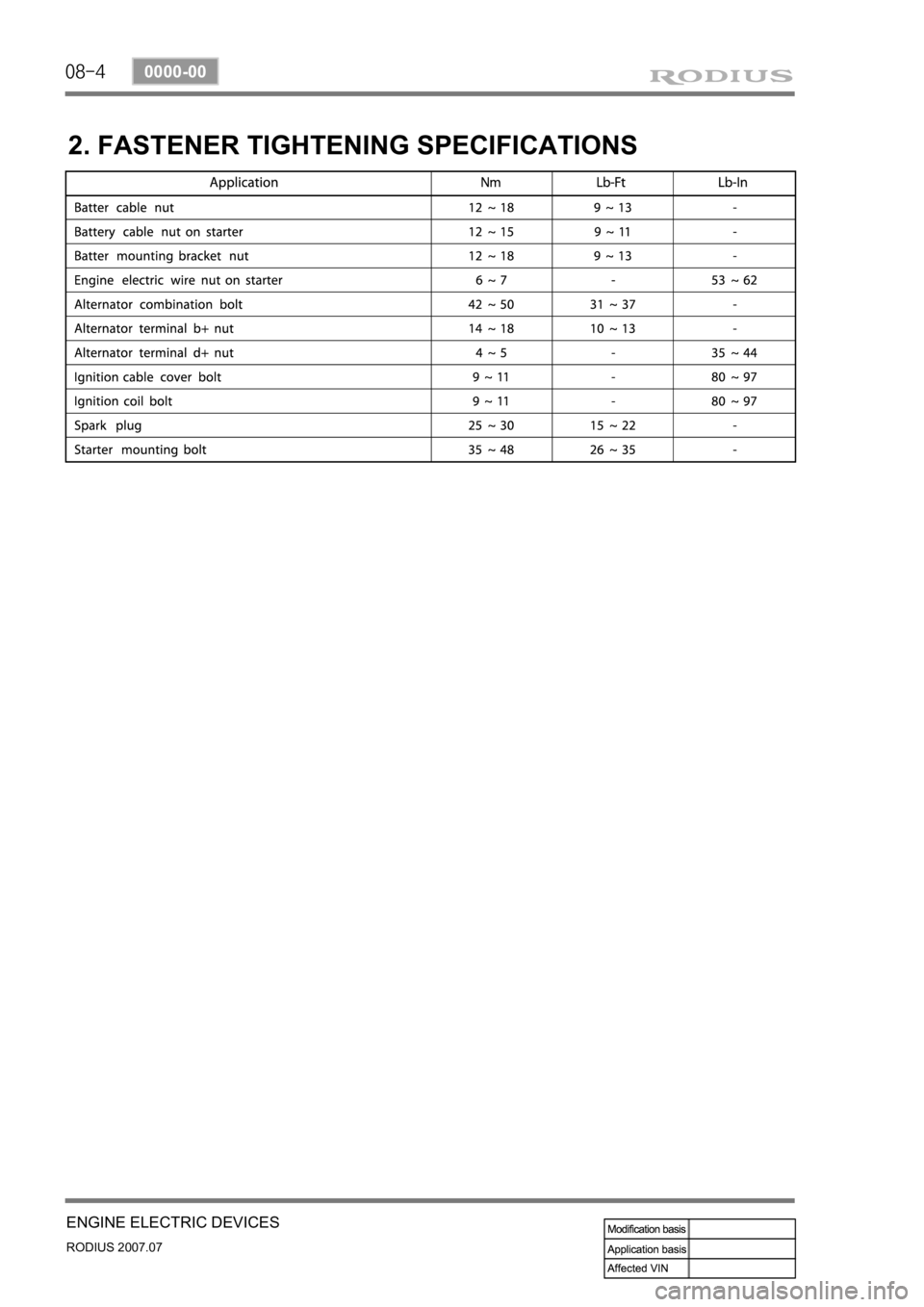SSANGYONG RODIUS 2006 Manual Online
RODIUS 2006
SSANGYONG
SSANGYONG
https://www.carmanualsonline.info/img/67/57523/w960_57523-0.png
SSANGYONG RODIUS 2006 Manual Online
Trending: alternator, fuse box, ABS, coolant, CD changer, fuel filter, display
Page 81 of 444

06-4
RODIUS 2007.07
0000-00
LUBRICATION SYSTEM
NO. FUNCTION NO. FUNCTION
1 Oil pump 18 Oil supply (to exhaust camshaft)
2 Oil gallery (to oil filter) 19 Oil supply (to intake camshaft)
3 Oil filter 20Oil supply
(to exhaust camshaft bearing)
4 Oil pressure switch 21Oil supply
(to intake camshaft bearing)
5 Main oil gallery 22Oil gallery
(oil supply to exhaust valve tappet)
6 Cylinder head closing cover 23Oil gallery
(oil supply to intake valve tappet)
7 Oil gallery (at chain tensioner) 24 Camshaft closing cover
8 Oil non-return valve 25Ball (φ 8 mm)
9 Chain tensioner 26 Screw plug
10 Vent (chain tensioner) 27 Camshaft adjuster
11Front closing cover (φ 17 mm)28Front closing cover
(intake camshaft)
12Oil gallery
(perpendicular to the shaft)29Front treaded bushing
(exhaust camshaft)
13Ball (φ 6 mm)30 Valve tappet
14 Oil spray nozzle (timing chain) aOil gallery
(from oil pump to oil filter)
15 Oil gallery (at cylinder head) b Main oil gallery
16Ball (φ 15mm)cOil return line
(oil returns to the oil pan when
replacing the filter element)
17Oil restriction inner (φ 4mm)
OIL CIRCULATION ▶
Page 82 of 444
07-3
COOLING SYSTEM
RODIUS 2007.07
0000-00
2110-01ENGINE COOLING SYSTEM
1. GENERAL SPECIFICATIONS
Page 83 of 444
07-4
RODIUS 2007.07
0000-00
COOLING SYSTEM
2. SPECIAL TOOLS AND EQUIPMENT
Page 84 of 444
07-5
COOLING SYSTEM
RODIUS 2007.07
0000-00
3. FASTENER TIGHTENING SPECIFICATIONS
Page 85 of 444

07-6
RODIUS 2007.07
0000-00
COOLING SYSTEM
1. GENERAL DESCRIPTION
The cooling system maintains the engine temperature at an efficient level during all engine
operating conditions. When the engine is cold, the cooling system cools the engine slowly o
r
not at all. This slow cooling of the engine allows the engine to warm up quickly. The cooling
system includes a radiator and recovery subsystem, cooling fans, a thermostat and housing, a
water pump, and a water pump drive belt. The timing belt drives the water pump.
All
components must function properly for the cooling system to operation. The water pump draws
the coolant from the radiator.
The coolant then circulates through water jackets in the engine block, the intake manifold, and
the cylinder head. When the coolant reaches the operating temperature of the thermostat, the
thermostat opens. The coolant then goes back to the radiator where it cools. This system
directs some coolant through the hoses to the heat core. This provides for heating and
defrosting. The coolant reservoir is connected to the radiator to recover the coolant displaced
by expansion from the high temperatures. The coolant reservoir maintains the correct coolant
level. The cooling system for this vehicle has no radiator cap or filler neck. The coolant is
added to the cooling system through the coolant reservoir.
Page 86 of 444
07-7
COOLING SYSTEM
RODIUS 2007.07
0000-00
2. COMPONENT LOCATOR
Page 87 of 444
07-8
RODIUS 2007.07
0000-00
COOLING SYSTEM
Radiator
Electric fan
Shroud
Deaeration tube
Clamp
Deaeration hose (radiator)
Electric fan mounting bracket
Bolt (M6, 8 pieces)
Bolt (M6, 4 pieces)
Bolt (M6, 4 pieces)
Upper radiator insulator
Lower radiator insulator
Plate
Clip 1.
2.
3.
4.
5.
6.
7.
8.
9.
10.
11.
12.
13.
14.Inlet hose
Outlet hose
3 way hose
Deaeration hose (reserver tank)
Clamp
Clamp
Make up hose holder
Reserver tank
Bolt (M6, 2 piece)
Cooling fan
Viscous clutch
Bolt (M6, 1 piece)
Bolt (M6, 3 piece) 15.
16.
17.
18.
19.
20.
21.
22.
23.
24.
25.
26.
27.
Page 88 of 444
08-3
ENGINE ELECTRIC DEVICES
RODIUS 2007.07
0000-00
1452-01ENGINE ELECTRIC DEVICES
1. GENERAL SPECIFICATIONS
Page 89 of 444
08-4
RODIUS 2007.07
0000-00
ENGINE ELECTRIC DEVICES
2. FASTENER TIGHTENING SPECIFICATIONS
Page 90 of 444

08-5
ENGINE ELECTRIC DEVICES
RODIUS 2007.07
0000-00
1. CHARGING SYSTEM OPERATION
Alternators use a new type of regulator that incorpo-rates a diode trio. A Delta stator, a rectifier
bridge, and a rotor with slip rings and brushes are electrically similar to earlier alternators.
A conventional pulley and fan are used. There is no test hole.
1) CHARGING TIME REQUIRED
The time required to charge a battery will vary depending upon the following factors:
▶ Size of Battery
A Completely discharged large heavy-duty battery required more than twice the
recharging time as a completely discharged small passenger car battery. -
▶ Temperature
A longer time will be needed to charge any battery at -18°C (0°F) than at 27°C
(80°F). When a fast charger is connected to a cold battery, the current accepted
by the battery will be very low at first. The battery will accept a higher current rate as the
battery warms. -
▶ Charger Capacity
A charger which can supply only 5 amperes will require a much longer charging period
than a charger that can supply 30 amperes or more. -
▶ State-of-Charge
A completely discharged battery requires more than twice as much charge as a onehal
f
charged battery. Because the electrolyte is nearly pure water and a poor conductor in a
completely discharged battery, the current accepted by the battery is very low at first.
Later, as the charging current causes the electrolyte acid content to increase, the
charging current will likewise increase. -
2. STARTING SYSTEM OPERATION
The engine electrical system includes the battery, the ignition, the starter, the alternator, and all
the related wiring. Diagnostic tables will aid in troubleshooting system faults. When a fault is
traced to a particular component, refer to that component section of the service manual. The
starting system circuit consists of the battery, the starter motor, the ignition switch, and all the
related electrical wiring. All of these components are connected electrically.
Trending: glove box, mirror, door lock, seats, overheating, fuel pressure, windshield wipers



















